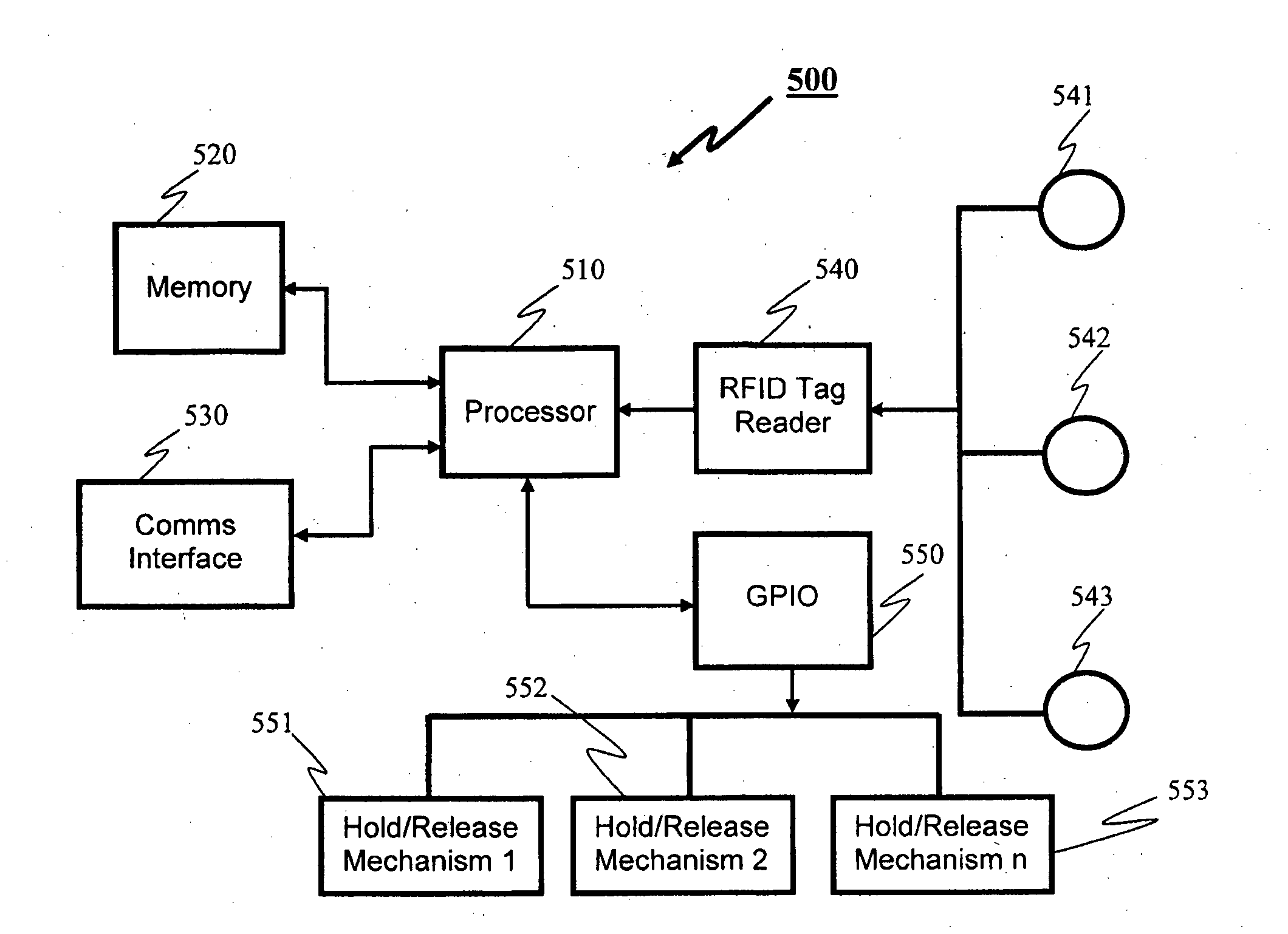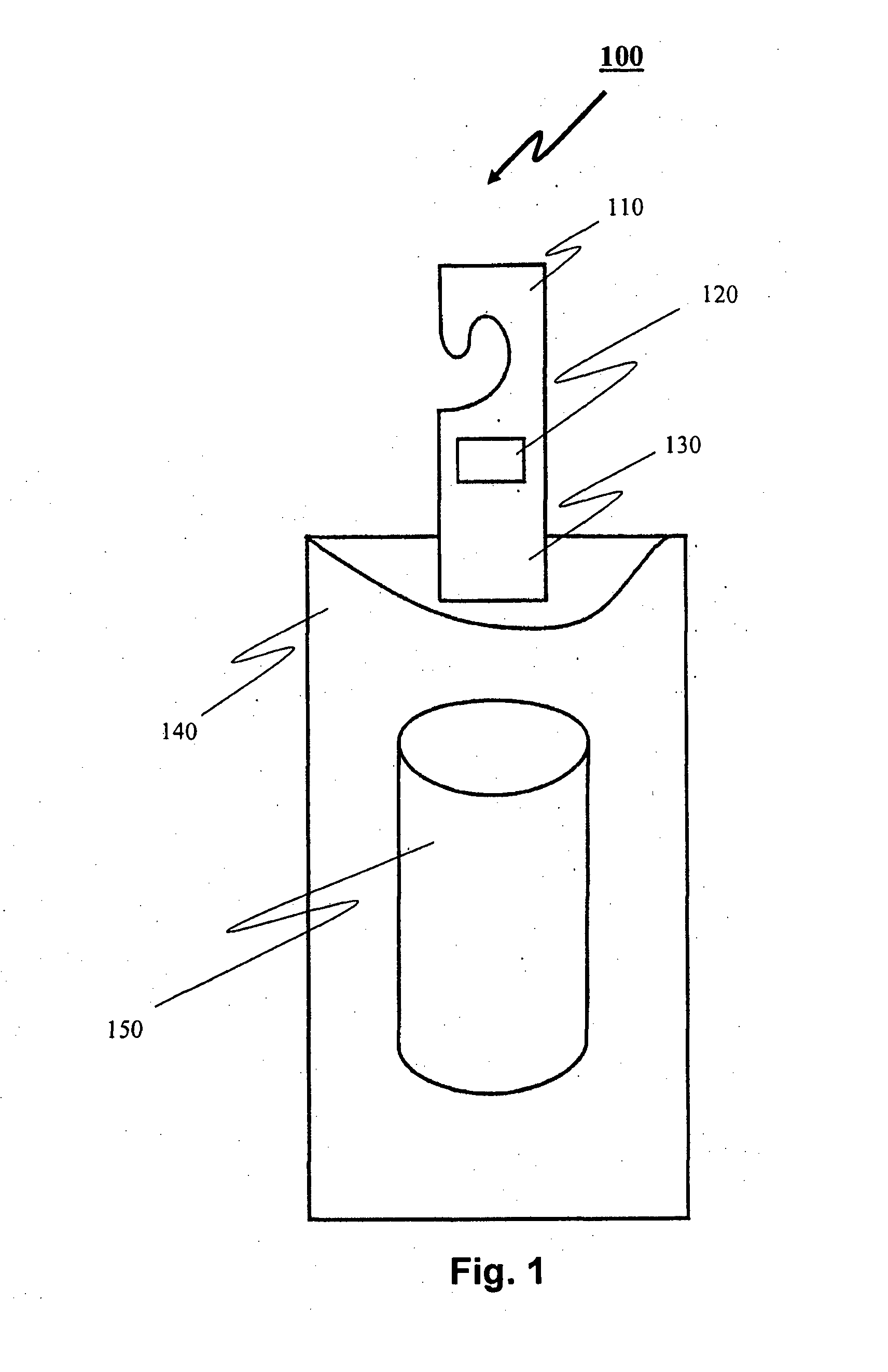[0019]In certain embodiments of the invention, the apparatus may be configured to dispense particular products based on a
unique identifier presented to the machine by the user. For example, the system of the current embodiment may include a system of hardware and
software to allow a doctor to enter in prescription information into a
computer terminal (hereinafter referred to as the “electronic prescription generating system”). This information may include a patient's name, the medication prescribed, and other pertinent information relating to the
medication prescription. This data may then be stored in a
central database. The said computer system may then generate a unique identification number sequence, which is entered into the automated dispensing machine of the current embodiment by either the patient or an authorized healthcare worker. Upon receiving this unique identification number sequence, the automated dispensing machine may reference the particular information in the
central database, it may, if required, verify credentials for security purposes (this may include biometric,
fingerprint scanner, iris
scanner or other suitable
verification methods), and thereafter dispense the required medication. The dispensing machine may thereafter update the
database so that the unique identification number cannot be used again. The benefit of this scheme is that the unique identification number sequence could be communicated to persons at a remote location, for example by phone, and this would allow the person immediate access to medication stored in the remote dispensing machine immediately, without them having to wait to receive a physical prescription, which may otherwise need to be sent by other means, for example mail.
[0020]In another embodiment, instead of generating a unique identification sequence to be entered into the machine, the electronic prescription generating system may relate a particular RFID tag or Bar Code to the records of a particular electronic prescription in the
database. In the case of an RFID Tag, it may optionally
encode further data on the actual RFID tag, for example referring to the number of repeats available on the prescription. In such an embodiment, the user simply presents the Bar Code to the Dispensing machines Bar Code Reader, or alternatively presents the RFID tag within the field of sensitivity of an RFID Reader antenna located on the outside surface of the dispensing machine. The dispensing machine will read the prescription's RFID tag (or Bar Code), and reference the relating data from the
central database. It may then optionally verify security credentials (e.g. Using Biometric
verification) before dispensing the correct medication. Prior to dispensing medication, it may also write information to the prescription's RFID tag, such as decrementing the data indicating the number of repeats available on the prescription, voiding the prescription, or recording any other pertinent data onto the prescription's RFID tag. Privacy may optionally be preserved by not storing specific
patient data and patient names on the prescriptions RFID tag, and the central
database may furthermore be restricted to the product that was prescribed, and not contain any personal data. In this way it is possible to preserve
anonymity and privacy in the system if required, and in this case having possession of the prescription's RFID tag (or in the case of Bar Codes being utilized, the bar code
label) would be all that is required by the patient or healthcare worker in order to access the medication stored in the dispensing unit.
[0022]In certain embodiments, it may not be as critical to ensure safeguards, to ensure the correct item has been loaded. For example in an application involving
snack foods, an incorrectly loaded snack item, while inconvenient and annoying for customers, would not present a risk to
human health. In such embodiments it may be preferred to save the costs of having a disposable RFID tag attached to each product (via the Hook
Assembly). In such eases the present embodiment offers an innovative way of preserving the detection capability of the RFID tag without making it a disposable item. This method involves applying the RFID tag directly onto the surface of the RFID reader antenna corresponding to the dispensed products “Hold / Release” mechanism. Instead of an RFID
label being applied to the Hook
Assembly (as in the usual operating mode), a conductive
metal foil sticker is applied to the Hook
Assembly in the same place as the RFID
label is usually placed. When the Hook Assembly, with product attached, is placed on the Hold / Release mechanism, the foil sticker has the effect of de-tuning the RFID label, resulting in it not being readable. As a consequence, the system is able to detect the presence of the product by establishing a “no read” condition for the RFID label relating to that specific Hold / Release mechanism, and the RFID Reader / Tag arrangement functions in a similar way as a
proximity sensor, detecting the presence or absence of the product based on whether the RFID tag stuck on the antenna is readable or non-readable. This mode of operation is therefore hereinafter referred to as “
proximity detection mode”. When operating in “
proximity detection mode” it is not possible to detect if the incorrect item has been placed on a particular Hold / Release mechanism, but in certain applications, the reduced operating costs resulting from preserving the RFID tags may outweigh this loss of safeguards, and in non-critical applications this mode of operation may be preferable. A dispensing machine may operate in either “
proximity detection mode” or full RFID
inventory management mode, or even a mixture of the two, as would be determined by the economics of the application.
 Login to View More
Login to View More  Login to View More
Login to View More 


